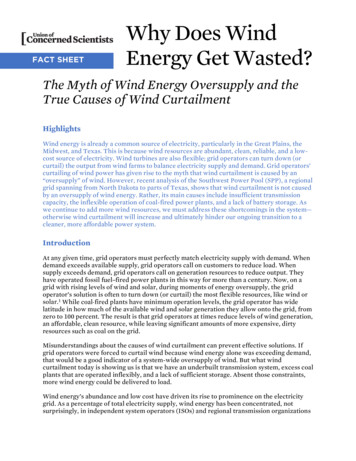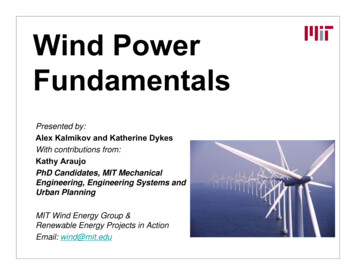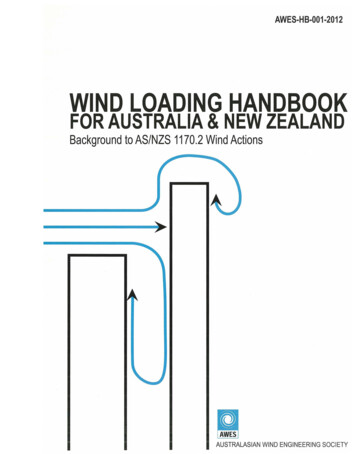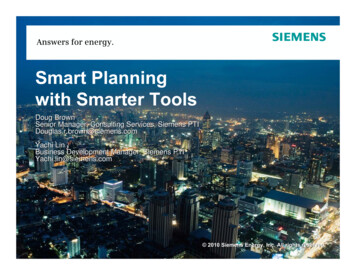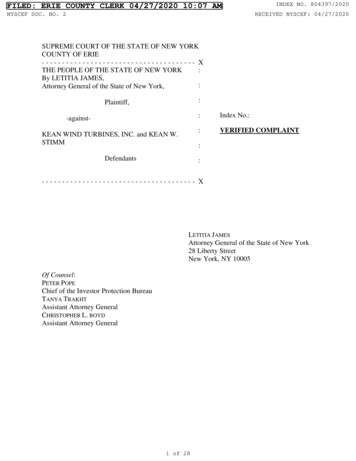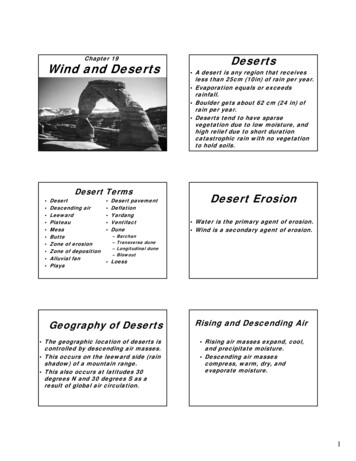
Transcription
Chapter 19Wind and Deserts Desert TermsDesertDescending airLeewardPlateauMesaButteZone of erosionZone of depositionAlluvial fanPlaya Desert archanTransverse duneLongitudinal duneBlowoutDeserts A desert is any region that receivesless than 25cm (10in) of rain per year. Evaporation equals or exceedsrainfall. Boulder gets about 62 cm (24 in) ofrain per year. Deserts tend to have sparsevegetation due to low moisture, andhigh relief due to short durationcatastrophic rain with no vegetationto hold soils.Desert Erosion Water is the primary agent of erosion. Wind is a secondary agent of erosion. LoessGeography of Deserts The geographic location of deserts iscontrolled by descending air masses. This occurs on the leeward side (rainshadow) of a mountain range. This also occurs at latitudes 30degrees N and 30 degrees S as aresult of global air circulation.Rising and Descending Air Rising air masses expand, cool,and precipitate moisture. Descending air massescompress, warm, dry, andevaporate moisture.1
Rising and Descending AirRising and Descending Air40Thought questionsGeography of Deserts Why are ski areas in Colorado on the west side of the divide?What is the prevailing wind direction?Is the air rising or falling on thewestern slope?Why is it so windy in Boulder?Does precipitation add or subtractheat from the air?Desert Landforms Desert regions with sedimentarybedrock develop characteristiclandforms.Desert Landforms:Plateau, Mesa, Butteplateau is a broad, level, elevatedregion commonly bounded partly by cliffs.–Amesa is smaller, flat-topped hillbounded by cliffs.– Abutte is a narrow hill of resistant rockbounded by cliffs.– A2
Desert Landforms:Desert Landforms:Desert Landforms:Desert Landforms:Desert LandformsZones of Erosion and DepositionPlateau, Mesa, ButtePlateau, Mesa, ButtePlateau, Mesa, ButtePlateau, Mesa, Butte Desert regions with igneous or metamorphicbedrock also develop characteristic landformswith– Zones of erosion which have little or no soil orvegetation, high relief and near total outcrop ofbedrock.– Zones of deposition which have low relief,some soil development, and sparse vegetation. Alluvial Fans are fan-shaped deposits ofmaterial in zone of deposition. Playa Lakes are ephemeral (temporary)lakes.3
Zones of Erosion and DepositionZones of Erosion and DepositionAlluvial FanAlluvial FansAlluvial Fan with Debris FlowsAlluvial Fan4
Playa LakeDunes and Deflation Wind moves sand and silt in zone ofdeposition. Silt and Clay are removed. Sand is moved to leeward end ofvalley to form a dune field. Pebbles and cobbles are left behind toform an desert pavement. Process is called deflation.Dune field, Great Sand near)Barchan Dunes:Crescent-shaped with limbsdownwind;Formed when sand movesacross outcrop / pavementBlowout Dunes:(Parabolic Dunes)Crescent-shaped with limbsupwind; formed when windsbreaks through vegetation5
Transverse Dunes:Perpendicular to wind direction;formed in regions of abundant sand(beaches).Longitudinal Dunes:Parallel to wind direction; formedin regions of limited sand.Longitudinal Dunes:DesertPavementDesertVarnishDesert Varnish6
DesertVarnishYardangs, IranResult from wind erosion ofpartially lithified dunes.Yardangs, IranResult from wind erosion ofpartially lithified dunes.Ventifactis a windfecetedcobble orpebbleLoess Silt and clay-sized particles aredeposited by wind in wetterregions.Loess Loess is a well-sorted depositof wind-deposited silt and claysized particles. Loess is a common peri-glacialdeposit.7
Desert TermsDesertDescending airLeewardPlateauMesaButteZone of erosionZone of depositionAlluvial fanPlaya Desert archanTransverse duneLongitudinal duneBlowout LoessClicker Question Temperate deserts primarily occur:– A. At 30º N and 30º S latitude and inthe rain shadows of mountainranges.– B. At the equator– C. Below mountain ranges– D. In Africa– E. In the southern hemisphere.Clicker Question Temperate deserts primarily occur:– A. At 30º N and 30º S latitude and in therain shadows of mountain ranges.– B. At the equator– C. Below mountain ranges– D. In Africa– E. In the southern hemisphere.Clicker Question A crescent-shaped sand dune with itslimbs downwind is a– A. Blowout dune– B. Barchan– C. Transverse dune– D. Longitudinal dune– E. WaddiClicker QuestionClicker Question A crescent-shaped sand dune with its A crescent-shaped sand dune with itslimbs downwind is a– A. Blowout dune– B. Barchan– C. Transverse dune– D. Longitudinal dune– E. Waddilimbs upwind is a– A. Blowout dune– B. Barchan– C. Transverse dune– D. Longitudinal dune– E. Waddi8
Clicker Question A crescent-shaped sand dune with itslimbs upwind is a– A. Blowout dune– B. Barchan– C. Transverse dune– D. Longitudinal dune– E. Waddi9
- A. Blowout dune - B. Barchan - C. Transverse dune - D. Longitudinal dune - E. Waddi Clicker Question A crescent-shaped sand dune with its limbs downwind is a - A. Blowout dune -B. Barchan - C. Transverse dune - D. Longitudinal dune - E. Waddi Clicker Question A crescent-shaped sand dune with its limbs upwind is a





